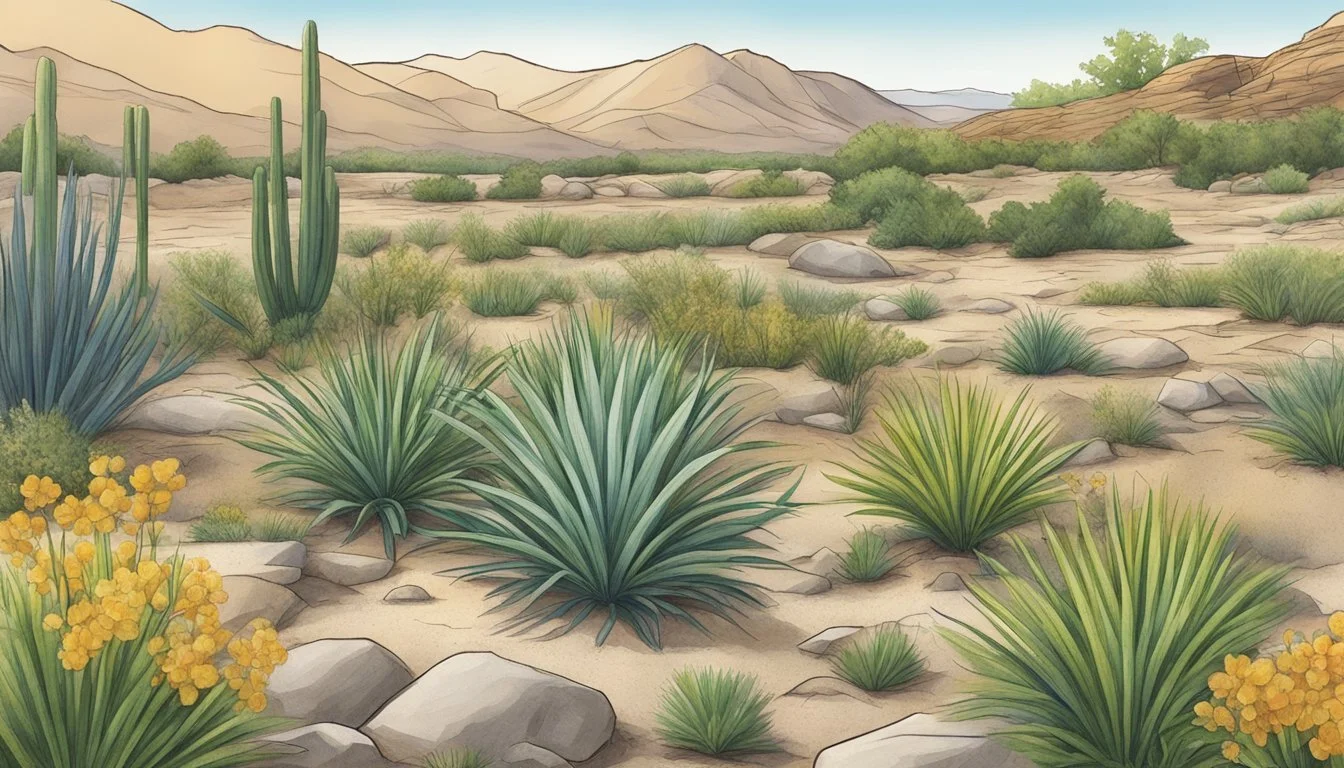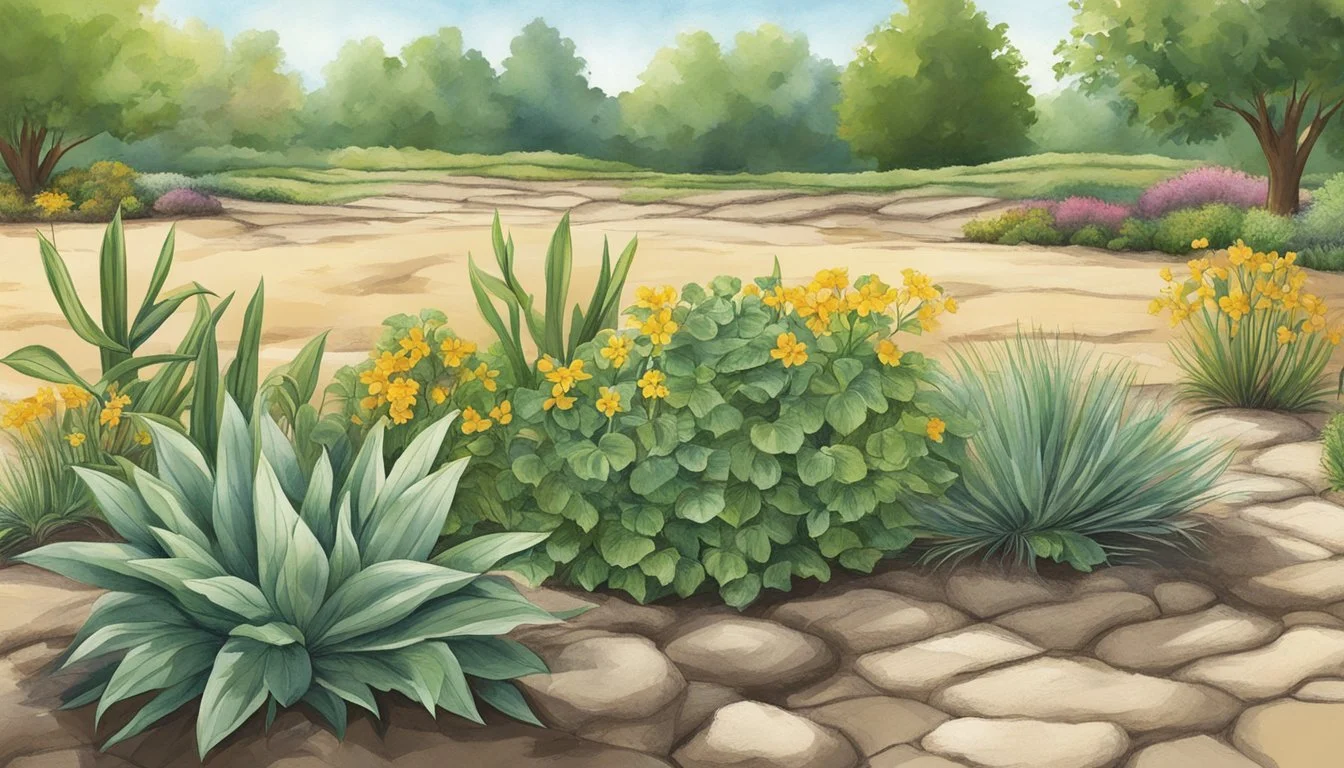Drought-Tolerant Plants in Ohio
Top Choices for Resilient Gardens
Drought-tolerant plants are a practical choice for gardeners in Ohio, addressing the challenges of water conservation while still maintaining beautiful landscapes. These plants are adept at surviving in environments with limited water supply, making them ideal for the varied Ohio climate, which can include dry spells. Incorporating plants that are naturally resilient to water scarcity is becoming increasingly important in North America as a whole, as it contributes to sustainable gardening practices and biodiversity.
In Ohio, gardeners have the advantage of a variety of native plants that are well-adapted to the local conditions and require minimal watering once established. From the sun-loving blue false indigo, a member of the bean family that enriches the soil by fixing nitrogen, to the vibrant butterfly milkweed, which not only conserves water but also supports pollinators like bees and butterflies, the choices are diverse and ecologically beneficial. By choosing the right plants, Ohioans can create thriving gardens that are both water-efficient and aesthetically pleasing.
Gardening with drought-tolerant plants does not mean compromising on beauty. Many of these species, such as the quick-growing black-eyed Susans, offer a burst of color and add a dynamic visual element to gardens. These plants are not only practical for managing resources but also play a pivotal role in creating sustainable landscapes that can withstand and adapt to Ohio's changing environmental conditions.
Understanding Drought-Tolerant Plants
In Ohio, the selection and understanding of drought-tolerant plants can be crucial due to unpredictable weather patterns. These plants offer resilience during dry spells and can thrive with minimal water inputs.
Defining Drought Tolerance
Drought-tolerant plants are specifically adapted to survive in conditions with limited water availability. They often possess physiological and structural traits that enable them to efficiently use water and store it within their tissues. Such plants maintain soil moisture balance through various tactics, such as deep root systems that reach for water deep in the ground or reduced leaf surfaces that minimize water loss. The ideal drought-tolerant specimen shows resilience during extended periods of drought without compromising its growth.
Benefits of Drought-Tolerant Landscaping
Integrating drought-tolerant plants into landscaping in Ohio can reduce maintenance requirements and promote sustainable water usage. Landscapes designed with these plants often require less frequent irrigation, diminishing the dependency on water resources. This is especially significant during prolonged dry spells when water conservation is paramount. Additionally, drought-tolerant landscapes typically demand less care, curtailing the need for resources such as fertilizers and pesticides which would otherwise be needed for less hardy plants.
Selecting the Right Plants for Ohio
Selecting the right plants for Ohio gardens hinges on understanding the local climate and soil composition, as well as choosing between native and non-native species that thrive within the USDA Hardiness Zones specific to the area.
Assessing Local Climate and Soil
When gardening in Ohio, one must first assess the local climate which falls predominantly within USDA Hardiness Zones 5, 6, and occasionally 7. This means that plants selected should be able to withstand cold down to -20 to 0 degrees Fahrenheit. Ohio's weather patterns can also influence gardening, with varying amounts of precipitation and potential drought conditions. Soil conditions vary across the state, but gardeners often face clay-heavy or poor-draining soils. It's crucial to amend these soils with organic matter to improve their structure and drainage or to choose plants that excel in these conditions.
Native vs. Non-native Species
Native plants are generally well-adapted to Ohio's environment, making them a suitable choice for gardeners looking to create a low-maintenance landscape. These species often require less watering and are more resilient to local pests and diseases. In contrast, non-native species may offer more variety but can demand more in terms of watering, especially if they're not suited to Ohio's variable conditions. They may also become invasive, outcompeting native species and disrupting local ecosystems.
When considering native plants, look for species that are evolved to Ohio's climate and soil. For example, plants like the Ohio Buckeye or Purple Coneflower are native to the area and are known for their ability to thrive in the local conditions. They are adapted to the region's weather and soil variations, from periods of heavy rain to times of drought, and can often prosper with minimal additional watering once established.
For gardeners dealing with wetter conditions or poorly draining soils, selecting plants like the Swamp Milkweed, a native perennial that thrives in wet land in Ohio, can be beneficial. Conversely, for drier areas, incorporating species that are drought tolerant, such as the Prairie Dropseed or Little Bluestem, both of which are suited for well-draining soils, may prove to be effective. These grasses not only tolerate occasional dry spells but also add texture and movement to the garden.
In any case, whether one opts for native or non-native species, considering the specific conditions of their landscape and selecting plants that are appropriate for their garden's unique microclimate and soil type is always a necessary step.
Designing a Drought-Tolerant Garden
Creating a drought-tolerant garden in Ohio means considering how sunlight and shade will impact plant growth. Gardeners must be strategic in their choices, ensuring that the plant's needs for full sun, shade, or a combination are met for optimal resilience and beauty.
Planning Your Garden Layout
A garden designed for drought tolerance requires thoughtful consideration of light exposure. In Ohio, areas that receive full sun can support a wide variety of drought-tolerant perennials and shrubs. Placement is crucial; one should position plants needing full sun to part shade in locations where they can benefit from the morning sunlight and enjoy some afternoon relief. Mapping out clusters of plants that have similar water and light needs can reduce maintenance and create aesthetically pleasing patterns of colors and green textures.
Combining Plants for Optimal Growth
Carefully selecting and combining plants is essential for a thriving, water-efficient garden. Drought-tolerant species can be grouped to create a full and lush appearance, despite low water availability. In particular, Ohio gardeners can incorporate a mix of native perennials and ornamental grasses, which, when planted in clusters, help to retain soil moisture and reduce evaporation. The focus on foliage color diversification is important; by arranging plants with silver, blue-green, and dark green leaves, one crafts a garden that is both robust and visually striking despite the rigors of a dry climate.
Top Drought-Tolerant Plants for Ohio
When considering drought-tolerant plants for Ohio gardens, it's essential to choose species that not only survive but also thrive with minimal water after establishment. Native perennials and wildflowers, resilient shrubs and trees, as well as hardy grasses and ground covers, are excellent choices for a water-efficient landscape.
Perennials and Wildflowers
Ohio's climate supports a variety of drought-tolerant perennials and wildflowers that bring color and resilience to gardens. Among them, the Black-eyed Susan stands out with its golden-yellow petals and dark brown center, requiring minimal moisture once established. Similarly, the Purple Coneflower proves to be a hardy choice with its distinctive cone-shaped center and pink to purple petals, attracting pollinators while conserving water. Wild Bergamot, also a favorite, offers fragrant foliage and lavender blooms, thriving in dry conditions, and the versatile Goldenrod presents a burst of vibrant yellow, adapting easily to Ohio's varying weather.
Black-eyed Susan (Rudbeckia hirta)
Purple Coneflower (Echinacea purpurea)
Wild Bergamot (Monarda fistulosa)
Goldenrod (Solidago spp.)
Shrubs and Trees
For structure and permanence, drought-tolerant shrubs and trees are essential to an Ohio garden. The deciduous shrub Russian Sage adds both texture and color with its silvery foliage and lavender-blue flowers. It requires infrequent watering once it takes root. Moreover, certain ferns can adapt to dryer conditions and provide a lush, green backdrop without needing constant moisture.
Russian Sage (Perovskia atriplicifolia)
Hardy Fern Varieties (Various species)
Grasses and Ground Covers
In terms of ground maintenance, ornamental grasses and ground covers are optimal for drought tolerance. Grass varieties like Blue Fescue offer year-round interest with minimal watering needs, while Daylilies present an array of colorful blooms with drought-resistant properties. For ground covers, look into plant species that spread easily and retain moisture, reducing the need for frequent irrigation.
Ornamental Grasses (Various species)
Daylilies (Hemerocallis spp.)
Caring for Your Drought-Tolerant Plants
Proper maintenance is crucial for the longevity and health of drought-tolerant plants in Ohio. They require specific watering, fertilizing strategies, as well as diligent pest and disease management to thrive in a garden.
Watering and Fertilizing
Drought-tolerant plants often have developed roots that are adept at seeking moisture deep within the soil. However, they still benefit from periodic deep watering which helps these plants establish an extensive root system. It is recommended to water them deeply but infrequently to encourage resilience, especially during the first growing season. When it comes to fertilizing, using a low-nitrogen, slow-release fertilizer once in the spring can support healthy growth without promoting excessive foliage that can stress the plant during dry periods.
Managing Pests and Diseases
Pest and disease management involves preemptive actions and prompt responses. Drought-tolerant plants are not completely immune to issues such as root rot which can occur if the plant is overwatered or if the soil does not drain well. Ensuring proper soil preparation before planting can significantly reduce this risk. As for animals, incorporating plants that are unpalatable to rabbits and deer can preserve your garden, as these creatures tend to avoid certain drought-tolerant species. Regular inspections can catch the early signs of infestation or disease, allowing for timely treatment with appropriate measures.
Seasonal Considerations
Drought-tolerant plants in Ohio must withstand seasonal extremes, from sub-zero winter temperatures to the scorching heat of summer. Gardeners should select species that are not only drought-resistant but also capable of surviving the harshness of these conditions.
Surviving the Winter Months
Ohio winters can bring prolonged periods of frost, challenging the hardiness of even the most resilient plants. It's crucial for gardeners to choose drought-tolerant plants that also possess the ability to endure cold snaps. For instance, plants like the butterfly milkweed are celebrated for their hardy nature, withstanding the stark Ohio winter without significant die-back.
Thriving in Summer's Heat
As temperatures rise in Ohio, summer's heat can be relentless, quickly sapping moisture from the soil. Drought-tolerant plants such as the black-eyed Susan and blue false indigo maintain their vibrancy even in peak summer conditions. These plants are well-suited to thrive in high temperatures as they have adaptations to retain water and manage heat stress effectively.
Attracting Wildlife with Drought-Tolerant Plants
In Ohio, turning to drought-tolerant plants is a sustainable method to maintain a vibrant garden that supports local wildlife without excessive water use. These plants prove beneficial for a variety of species ranging from pollinators to small mammals.
Plants such as the Achillea millefolium or Yarrow are drought-tolerant and serve as a magnet for butterflies and beneficial insects. The Asclepias tuberosa, commonly known as Butterfly Weed, not only withstands dry conditions but also acts as a host for monarch butterfly larvae, providing a vital resource for their survival.
Attractive Features: Bright, nectar-rich flowers
Wildlife Benefits: Attracts bees and hummingbirds
Attractive Features: Hardy foliage
Wildlife Benefits: Provides shelter for small mammals
Attractive Features: Seed-producing plants
Wildlife Benefits: Food source for birds
Furthermore, the Allium species offers eye-catching blooms while deterring unwelcome guests like deer and rodents, making them suitable for a pollinator garden in arid conditions. The fragrance and color of Anise Hyssop blooms in the late summer, drawing a diverse group of bees and butterflies due to its lavender flowers and scented leaves.
Incorporating these plants into an Ohio garden not only conserves water but also fosters a welcoming habitat for wildlife, ensuring a balanced ecosystem even in the face of drought. To explore some of these drought-tolerant options, one can find practical examples and further details on Water-Wise Wildlife Gardens and Drought Tolerant Native Wildflowers.
Propagation and Maintenance Strategies
Developing a successful garden with drought-tolerant plants in Ohio begins with understanding the most effective ways to propagate and maintain these resilient varieties. Prioritizing methods that minimize maintenance without sacrificing plant health is key.
Seed Propagation
Seed Selection: Selecting high-quality, drought-resistant seeds is essential. It's crucial to start with seeds that are adapted to thrive in Ohio's occasional dry spells. These seeds often require less water and are better suited to the local climate's variability.
Sowing Method: Sow seeds in well-draining soil to prevent waterlogging. Incorporating organic matter can improve soil structure and water retention, allowing for slow and deep irrigation that encourages strong root growth.
Care Post-Germination: Once seeds germinate, consistent care leads to robust seedlings. Although drought-tolerant plants are low-maintenance, they may need more attention in their infancy, including regular watering until established.
Transplanting and Dividing
Transplanting: Transplant young plants during cooler parts of the day to reduce stress. Soil should be moist at the time of transplanting to help ease the transition. Ensure the plant is placed at the same depth it was growing previously.
Dividing: For perennial species, dividing mature plants can propagate new growth. This is best done in the spring or fall when temperatures are mild. Dividing helps to rejuvenate older plants and increase airflow, reducing the potential for disease.
Aftercare: Post-transplant, regular watering helps plants to establish. However, over time, maintenance can be minimized as plants adapt to their environment. One may occasionally need to deadhead spent flowers to encourage further blooming and maintain plant vigor.
Environmental Impact and Sustainability
Drought-tolerant plants play a crucial role in the different facets of environmental sustainability in Ohio. They provide support for local ecosystems while conserving precious water resources.
Conserving Water Resources
Drought-tolerant plants require less water than traditional species, which leads to a significant reduction in water usage. In Ohio, where precipitation patterns have shifted and extreme weather events have become more common, utilizing drought-resistant crops like corn hybrids designed for these conditions can be a key risk management tool. Such plants help maintain agricultural productivity even during periods of water scarcity. They are an integral part of a sustainable agricultural strategy in the fight against the increasing variability of climate patterns.
Supporting Ecosystems
By incorporating drought-tolerant species, Ohio can support more resilient ecosystems. These plants provide essential support to local biodiversity by maintaining ground cover and reducing soil erosion during dry spells. They serve as a habitat and food source for pollinators and other wildlife, which reinforces the ecological balance. The presence of such species aids in stabilizing the local environment, buffering against the abrupt changes caused by drought conditions, and thus minimizing the adverse environmental impact.
Using Drought-Tolerant Plants in Landscaping
Incorporating drought-tolerant plants into Ohio landscaping offers both aesthetic appeal and practical benefits. This approach is essential for creating resilient gardens that require less irrigation and maintenance.
Residential Landscaping
Homeowners can transform their yards into lush, low-water landscapes by carefully selecting drought-tolerant species that thrive in Ohio's climate. A reputable nursery can provide guidance on plants like sedum, cone flowers, and ornamental grasses that are well-suited for residential settings. The design of a drought-tolerant residential landscape should consider sun exposure, soil type, and drainage to optimize plant health and water conservation.
Key Plants:
Sedum (Sedum spp.)
Cone Flower (Echinacea spp.)
Ornamental Grasses (Miscanthus spp., Pennisetum spp.)
Residents should plan their gardens with zones based on water needs, clustering the most drought-tolerant plants in the driest areas.
Commercial and Public Spaces
Drought-tolerant landscaping in commercial and public spaces not only conserves water but also serves as a demonstration of sustainable practices. For large-scale landscapes, the design aspect becomes crucial to handle the vast areas while maintaining an aesthetic appeal. Plants like juniper and Russian sage can cover ground effectively with minimal water use and offer visual interest throughout the seasons.
Recommended Ground Covers:
Juniper (Juniperus spp.)
Russian Sage (Perovskia atriplicifolia)
These spaces should incorporate mulches and hardscapes to reduce evaporative water loss and to provide contrast and structure to the plantings.
Additional Resources
When seeking information about drought-tolerant plants suitable for Ohio's climate, gardeners can benefit from various authoritative resources. Here are some recommended tools and insights:
Government Agencies and Educational Institutions:
The U.S. Environmental Protection Agency offers guidelines on water-efficient landscaping and selecting plants that require minimal watering in Ohio.
Organizations:
The Garden Club of Ohio provides practical tips on xeriscaping, encouraging the use of mulch and the integration of drought-tolerant ground covers to conserve water.
Online Guides and Articles:
LawnStarter offers a guide on the top 10 Ohio native plants that are drought-resistant and easy to maintain, highlighting their suitability for local gardens.
Local Authorities:
Information on a variety of shrubs that withstand dry conditions can be found through resources recommended by The Ohio State University Extension.
Native Plant Lists:
The Ohio Department of Natural Resources provides extensive lists of native plants, which are generally more drought-tolerant and low-maintenance.
For individual purchasing needs, they should consider visiting local nurseries that specialize in native and drought-resistant species, offering firsthand advice and plant options that thrive in Ohio's unique conditions. It's advisable to consult with nursery professionals about the specific needs of their garden to ensure successful cultivation of drought-tolerant plants.
Conclusion
Drought-tolerant plants are invaluable in Ohio landscapes due to their resilience and low-maintenance qualities. With climate variability, these plants offer practical solutions for sustainable gardening and landscaping. They can survive with minimal watering, reducing the demand on local water resources and helping to conserve water.
Ohio gardeners and landscapers are encouraged to consider these adaptable species when designing their green spaces. Plants such as the Ohio prairie native purple coneflower and butterfly milkweed not only withstand dry periods but also provide crucial habitat for local wildlife. The use of drought-resistant crops and innovative methods like the use of superabsorbent hydrogels have significance in agricultural settings, enhancing food security.
For optimal results, it is recommended to:
Assess local soil conditions and select plants that thrive in Ohio's variable climate.
Incorporate biochar and other soil amendments to improve water retention.
Consult the USDA plant hardiness zone map to determine the suitability of plant species for specific areas in Ohio.
In conclusion, the inclusion and promotion of drought-tolerant plants are vital for Ohio's ecological and agricultural stability. Through careful selection and management, they contribute to biodiversity while addressing the challenges posed by drought conditions.
Frequently Asked Questions
Ohio's climate presents unique challenges for gardening, making drought tolerance a valuable plant trait. The following FAQs address common concerns regarding the selection of drought-tolerant plants for Ohio gardens.
What are the best drought-tolerant perennials for full sun in Ohio zone 5?
Some of the top drought-tolerant perennials for Ohio's full sun, zone 5 gardens include Sedum (Stonecrop), Echinacea (Coneflower), and Rudbeckia (Black-eyed Susan). These resilient plants can withstand dry spells and thrive in the heat.
Which drought-tolerant yellow flowering plants thrive in Ohio?
Ohio gardens can benefit from yellow flowering plants like Achillea (Yarrow) and Helianthus (Perennial Sunflower). These species are well-adapted to dry conditions and add a vibrant pop of color.
Can you list low maintenance, drought-tolerant landscaping plants suitable for Ohio?
Landscapers in Ohio often recommend plants such as Juniperus (Juniper), Diervilla (Bush Honeysuckle), and Festuca (Blue Fescue). These plants require minimal upkeep and are drought-resistant, making them suitable for Ohio landscaping.
Are there any evergreen plants that are drought-tolerant and suitable for Ohio's climate?
Evergreen options that tolerate drought and suit Ohio's climate include Juniperus (Juniper) and Buxus (Boxwood). They provide year-round greenery with less frequent watering.
What native Ohio perennials require minimal water?
Native Ohio perennials like Asclepias tuberosa (Butterfly Weed) and Rudbeckia hirta (Black-Eyed Susan) are excellent choices for water-wise gardens. They require minimal water once established and support local ecology.
Which drought-tolerant plants are recommended for container gardening in Ohio?
Container gardening in Ohio can flourish with drought-tolerant plants such as Sedum (Stonecrop) and Lavandula (Lavender). These plants adapt well to container life and require less watering.














